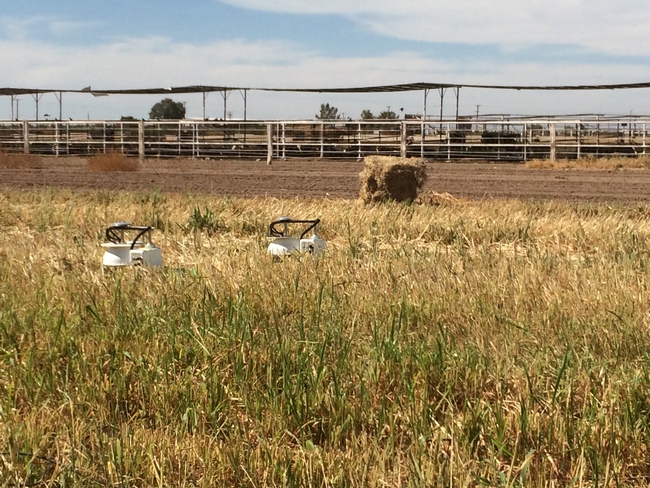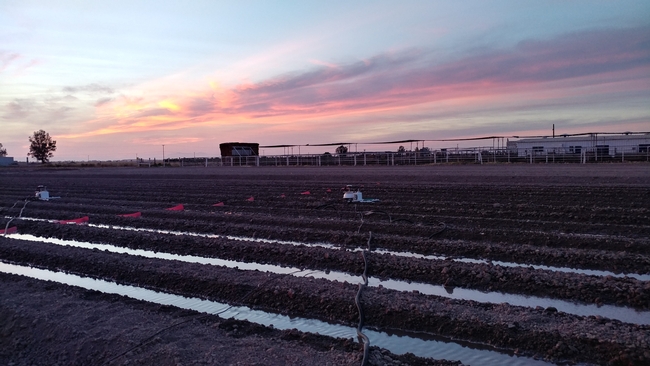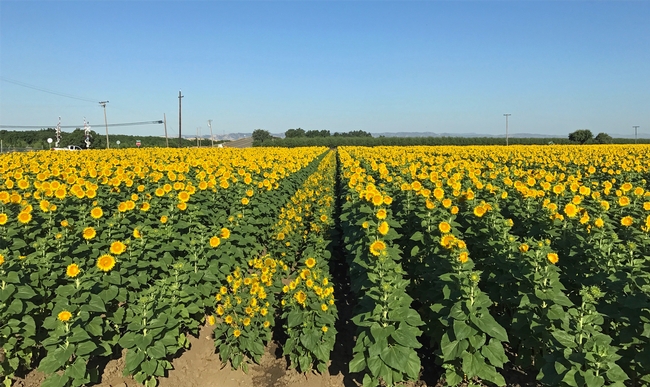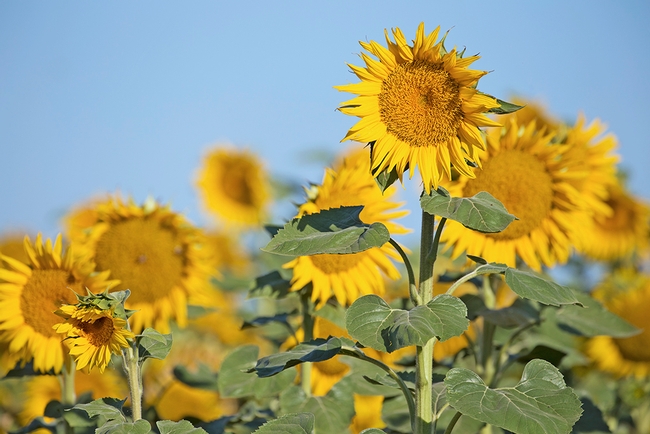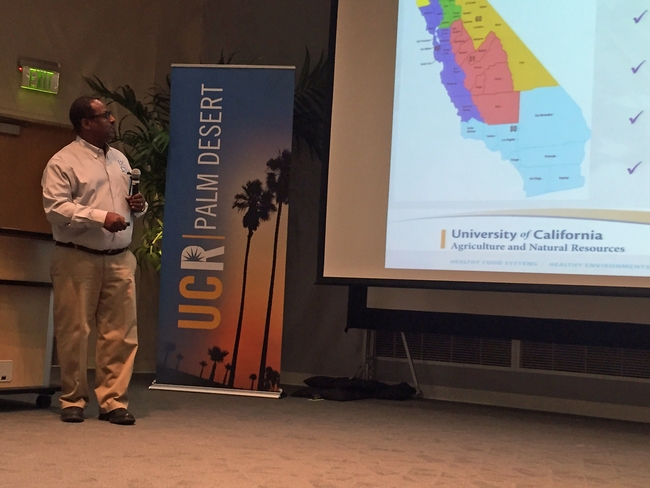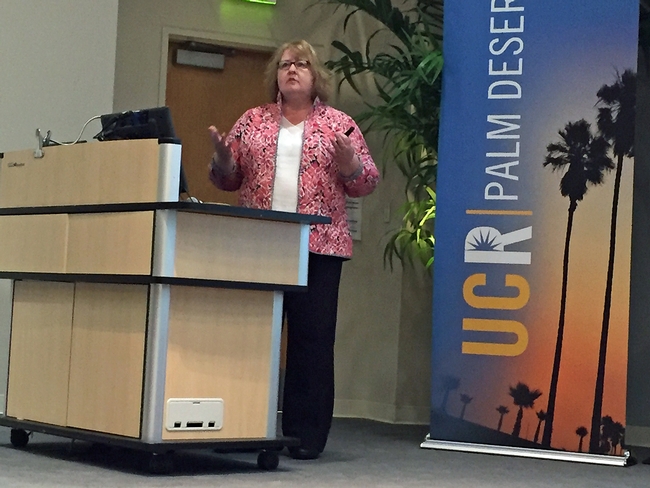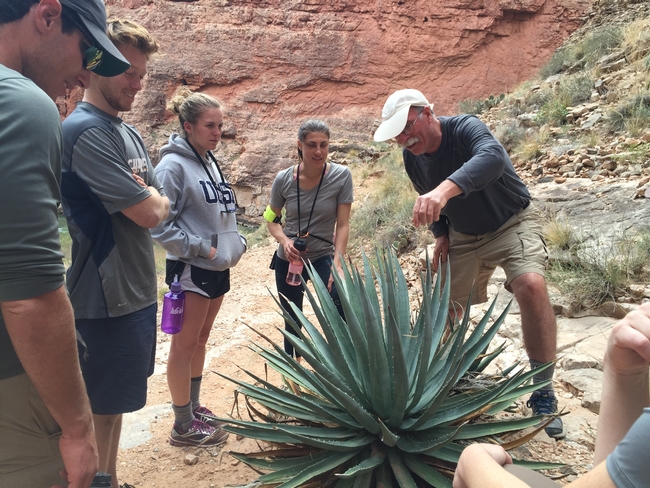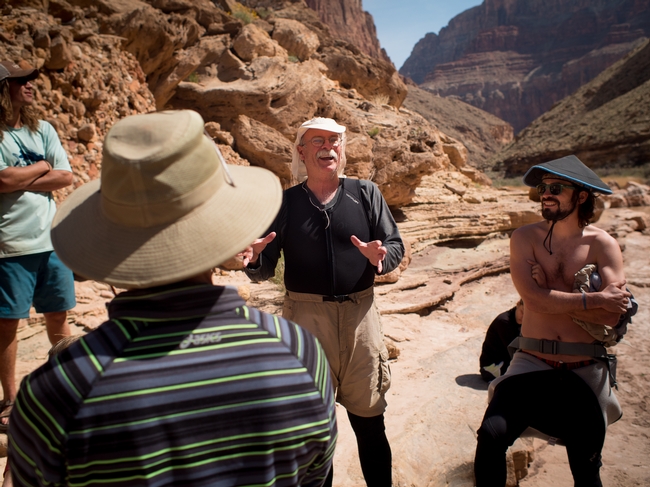Posts Tagged: desert
Drip irrigation in arid regions can cut greenhouse gas emissions, improve air quality
Study at Desert Research and Extension Center highlights agriculture's sustainability role
Under the blistering sun of Southern California's Imperial Valley, it's not surprising that subsurface drip irrigation is more effective and efficient than furrow (or flood) irrigation, a practice in which up to 50% of water is lost to evaporation.
But a recent study also concludes that drip irrigation can dramatically reduce greenhouse gas emissions from soil – which contribute to climate change and unhealthy air quality in the region – without sacrificing yields of forage crops alfalfa and sudangrass.
“It was really exciting to see,” said lead author Holly Andrews, a National Science Foundation postdoctoral fellow at the University of Arizona. “The crop yield was at least maintained and in some cases increased, but the water use and gaseous emissions were especially decreased under drip irrigation.”
Desert REC crucial to collecting data
Andrews and her colleagues gathered data from field studies at University of California Agriculture and Natural Resources' Desert Research and Extension Center, a crucial hub of desert agriculture research for more than 100 years. Studies in that context are increasingly important, as much of California and the Southwest becomes hotter and drier.
“We already have this history of looking at drip irrigation at this site, so our study was trying to build on that,” said Andrews, who lauded Desert REC's facilities and staff.
In their study published in Agriculture, Ecosystems & Environment, researchers found that – in comparison to furrow irrigation – drip irrigation in alfalfa slashed per-yield soil carbon dioxide emissions by 59%, nitrous oxide by 38% and nitric oxide by 20%.
Nitrous oxide is a greenhouse gas with nearly 300 times more warming potential as carbon dioxide, and nitric oxide is a precursor to ozone and major contributor to air pollution.
While drip irrigation only decreased water demand 1% in alfalfa, the practice led to a substantial 49% decrease in irrigation for sudangrass. For more fertilizer-intensive sudangrass, drip irrigation also reduced soil emissions of nitrous oxide by 59% and nitric oxide by 49% – the result of drip irrigation making those fertilizers more efficient.
Water management can help mitigate climate change
Studying alfalfa and sudangrass – forage crops with very different fertilizer requirements – was a strategic choice by the researchers. They are number one and number three on the list of most widely grown crops by acreage in the Imperial Valley (Bermudagrass, another forage crop, is number two).
With so much land dedicated to producing these crops, the adoption of drip irrigation at scale could deliver significant benefits to residents' health and quality of life.
“The thought that saving water can increase yields while lowering the emission of trace gases that affect regional air quality and Earth's climate is quite encouraging,” said Pete Homyak, an assistant professor of environmental sciences at UC Riverside who contributed to the study. “This is especially true for the Imperial Valley, an arid region where water is a limited resource and where residents are exposed to bad air quality.”
Homyak, who is affiliated with UC ANR through UC Riverside's Agricultural Experiment Station, said that this study illustrates how changes in water management can substantially mitigate agricultural impacts on the environment.
The study findings should encourage growers to replace furrow irrigation systems with drip irrigation infrastructure – especially in combination with financial incentives from the state, such as cap-and-trade and carbon credit programs, that can help defray high installation costs.
“It really is worthwhile if you're thinking sustainability and environmental activism in how agriculture can actually support climate change mitigation,” Andrews explained. “These practices might be a way that we can start to change that picture a little bit – and make agriculture more sustainable by tailoring irrigation management to local climate conditions.”
In addition to Andrews and Homyak, the other study authors are Patty Oikawa, California State University, East Bay; Jun Wang, University of Iowa; and Darrel Jenerette, UC Riverside.
Radiant daisy-like sunflowers produce a valuable crop with little water
Sweeping acres of striking golden flowers may soon grace California's desert southwest. UC Cooperative Extension irrigation specialist Khaled Bali believes sunflowers may be an ideal crop for the state's most punishing agricultural region.
California produces more than 90 percent of the country's hybrid sunflower planting seed, which is shipped around the nation and world. The seed is used to grow sunflower seeds for a healthy snack or salad topper, and for seeds that are expressed into sunflower oil, valued for its clean taste and polyunsaturated fat.
Most California seed is produced on about 50,000 acres in the Sacramento Valley. But the plant's low water use and early maturity hold promise for production in Southern California's low desert.
Bali's research began two years ago with 1,800 plots of sunflowers, nearly 300 different genotypes, at the UC Desert Research and Extension Center in Holtville. All plants were well-watered for four weeks before drought treatment started. In 2016, the trial plots were irrigated at 60 percent of the area's ETo (the full amount of water used by well-irrigated, mowed grass in that environment), and at 100 percent.
“Sunflower is a California native species grown as a hybrid seed crop,” Bali said. “With limited water, we wanted to look at varieties that tolerate drought and stress.”
That year, Bali found significant variation in yield across the varieties, but no difference between plots that received 60 percent of ETo and 100 percent
“I've been doing deficit irrigation for a long time,” Bali said. “I never expected that.”
For the 2017 season, the 60 percent ETo plots were dropped to 10 percent to better understand the implications of severe drought on the sunflower cultivars.
“The emphasis in 2017 was to intensify our drought treatment, giving less water earlier and to quantify the genotypes' drought avoidance strategy by digging up roots and using computer image analysis to determine root traits,” Bali said.
Bali attributes the sunflower crop's low water needs to its deep tap root and crop production timing. Sunflower in the low desert may be planted from January to February, and harvested in May and June.
“Sunflower water needs are relatively low since they are harvested before the hottest part of the summer,” Bali said.
His research is continuing in 2018.
A new UC publication, Sunflower Hybrid Seed Production in California, is now under review and is expected to be available to producers in fall 2018. Written by UC Cooperative Extension advisor Rachael Long and colleagues, including Bali, the publication outlines crop production standards, land preparation, fertilization, pest management, harvesting and more.
Long said sunflowers are favored for crop rotations because they help in long-term management of weeds and diseases, the plants add biomass to the soil after harvest, and they are a profitable specialty field crop.
Read more about California sunflowers in a Green Blog post by Rachael Long, Sunflower seeds are boosting California's ag economy.
California’s desert agriculture is hot stuff
Stretching from the Death Valley to Calexico, California's vast dry desert is home to a unique and important agriculture industry.
It's a place where summertime temperatures often top the 115-degree mark. Where water supplies for irrigation depend on the Colorado River, but upriver states are claiming more of it. Where evapotrasporation – a reference rate of water use in unstressed turf grass – is 72 inches per year, but rainfall is rarely more than 4.
Still, stalwart farmers grow dates, carrots, lettuce, broccoli, cabbage, kale and more, plus plants for landscaping everything from family homes to beautiful and luxurious resorts. The agriculture output of the state's three desert counties – Riverside, San Bernardino and Imperial – exceeds $4 billion annually.
The California desert also impacts the quality of life across the nation. If Americans are enjoying a salad in the winter, the lettuce most likely was grown in the California desert. There are bountiful winter recreation opportunities available on the beautifully manicured golf courses, parks and landscapes.
A group of UC Agriculture and Natural Resources (UC ANR) academics formed a desert workgroup to better serve the state's desert region. The group organized a symposium in February to bring together representatives from desert farm and natural resources communities, related industry and academics working in the desert.
“The close exchange of information among desert researchers, non-profit organizations, industry and clientele groups will facilitate collaboration among UC ANR, Arizona and Mexico and foster how our programs should be shaped on a regional level,” said Oli Bachie, the director of UC Cooperative Extension in Imperial County and the current workgroup chair.
With saline soil, scorching summer temperatures and limited water supplies, the desert could be considered a hotbed of the “wicked problem.” A wicked problem isn't evil, said UC Associate Vice President Wendy Powers, the symposium's plenary session keynote speaker.
“The term ‘wicked problem' was coined at UC Berkeley,” Powers said. “It's a problem with circumstances that resist resolution.”
She named climate change and the growth of the global population California must help feed as wicked problems faced by the state. Powers described UC ANR's statewide programs that are working to find solutions to formidable issues faced in California agriculture.
“We're on the verge of some serious breakthroughs as we look at solving wicked problems,” Powers said. “They are accelerated by conversations like those we're having today.”
UC Vice Provost Mark Bell said that the potential of UC ANR to reach every single Californian is what drew him to his position in 2017. Bell invoked Star Wars robot R2D2 for an acronym to reflect the characteristics that accurately define UC ANR.
“R2 stands for reach and relevance,” he said. “D2 is diverse and dispersed.”
UC Cooperative Extension offices serve 57 California counties and its nine research and extension centers are located in key agriculture ecosystems, including one in the low desert of the Imperial Valley.
The afternoon program of the symposium included breakout sessions to highlight programs and research efforts in three broad areas: irrigation and crop production, landscape management, and livestock and feed quality.
“This was the first attempt to organize such a regional desert-based symposium for the UCANR Desert Workgroup with the collaboration of desert-serving UCCE counties,” Bachie said. “I believe that we have registered a remarkable get-together.”
The symposium had speakers and participants from UC, USDA, California Department of Food and Agriculture, the desert agricultural industry, pest control advisors, non-profit institutions and organizations, agricultural commissioners, farm bureaus, Arizona and Mexico universities and the general public.
“I believe that the symposium is a stepping stone for future desert research and extension meetings, conferences and symposiums among people engaged or interested in desert agriculture and natural resources,” Bachie said.
Rachael Long: A Boy, a Bat, a Coyote and a Crow
It doesn't get more real. Yolo County Farm Advisor and children's book author Rachael Freeman Long remembers telling her son stories about an...

Pallid bats, shown here hanging upside down, were featured at Rachael Long's presentation on her second book, "Valley of Fire,"at the Avid Reader, Davis. She will speak on her latest and last book in the trilogy, "River of No Return," at 1 p.m., Saturday, Aug. 20 at the Avid Reader. (Photo by Kathy Keatley Garvey)

Rachael Long, in a presentation at the Avid Reader, shows a bat house. (Photo by Kathy Keatley Garvey)
Canyon Classroom: Exploring the Grand Canyon's plants along the Colorado River
While some people were spending spring break at the beach or catching up on their Netflix queue, students from the EcoGeoMorphology class at UC Davis were rafting down the Colorado River at the bottom of the Grand Canyon.
[Join the journey: UC Davis Grand Canyon interactive website, http://grandcanyon.ucdavis.edu.]
The class split in two groups for the 225-mile river journey. On March 10, the group embarked from Lee's Ferry, rafting 90 miles before hiking to the rim on March 19 along Bright Angel Trail. They passed the second group on their way down the same day. They traveled the remaining 135 miles to the next road access at Diamond Creek.
The class is conducted during winter quarter by the Department of Earth and Planetary Sciences and the Center for Watershed Sciences, in partnership with Campus Recreation's Outdoor Adventures. While its first trip to the Grand Canyon was in 2003, students have taken this optional trip for each of the past five years.
Among the class' instructors this year was UC Davis plant sciences professor and UC Agriculture and Natural Resources affiliate Truman Young.
‘There's nothing quite like this'
The trip is the physical and visible representation of what the class is all about: Geologists, hydrologists and ecologists learning to communicate with each other and the public. It's a skill necessary in real-world careers, where working on environmental problems requires a variety of expertise that isn't always taught in siloed classrooms.
“I'm not a geologist myself, but you only have to look left to right at any moment, and there's nothing quite like this,” said Young while floating down the river, taking in the cliffs rising around him.
The classrooms are pretty spectacular: red walled caverns, ancient Puebloan ruins, rock formations and fossils, the river itself. It's the students' textbooks brought vividly and tangibly to life.
Along the way, Young described the life cycle of Century plants; explored the plants sprouting around Vasey's Paradise, a natural spring; and rubbed scale insects off prickly pear plants to expose the crimson dye they produce. At each step, he casually prodded the students to consider what it means to have a river running through a desert.
Time travelers
The group was unplugged, off-grid, and literally immersed in the river, rocks and landscape.
Geologists, ecologists, and hydrologists helped teach each other about rocks, plants, fish and flow rates—usually informally as they scrambled up a trail or gazed up at the vertical cliffs slowly floating past.
They slept each night under a sky bright with forgotten stars, to the sounds of softly strumming guitar and the nearby rushing river.
Over the course of eight days on the river, they traveled through about a billion years of geologic time.
Young had been on the trip once before, two years ago. He said it was just as impressive the second go-around.
“It's actually more spectacular on the second pass, which surprised me,” he said. “Just the magnitude and the grandeur of it, all that stuff. It's just more.”


